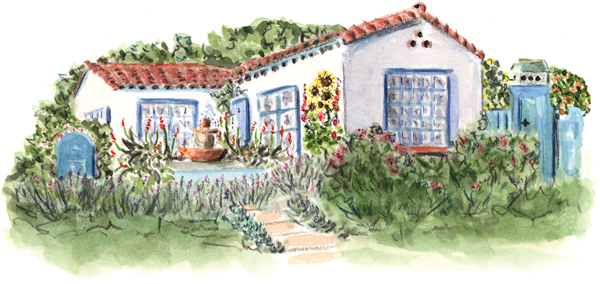

My grandchildren surge through our kitchen door like a tumbling stream, laughing and calling excitedly, as though visiting Amma’s house is the best thing in the world. That’s exactly how I want them to feel and how I felt whenever I ran the pathway of hollyhocks to my Grandmother Lovejoy’s cottage or threaded up the ribbon of walkway to my Nonie’s bungalow. My heart would pound in anticipation. I never knew what we were going to do, but I always knew that I could count on something out-of-the-ordinary to happen—not an extraordinary experience like panning for gold or discovering a new comet, but something wonderful, simple, and memorable that could happen only with a caring and loving grandmother.
A grandchild’s visit is one of the greatest adventures for a grandmother, but it can also be a bit daunting. You may wonder how you’re going to fill all the hours between waking and sleep, but luckily the most important ingredient for success is you. Lucky you. You’re in for an unforgettable experience.
Running a successful and fulfilling Camp Granny isn’t about having a giant flat-screen television with 300 channels, a big swimming pool, or the latest computer games—it is about you and the time you share with your grandchild. My friend Nana Bonny hosts her long-distance grandchildren often, and for her, the experience is all about time together and time in nature. On their first morning, she greets her grandchildren with a cup of hot cocoa and a quick trip to the beach to watch the day begin. “We like having our footprints be the first ones in the sand.” A grandchild doesn’t forget an experience like that.
Your time together is magical, an accretion of memories, stories, traditions, and simple pleasures that, when cemented together through the years, make for one of the most important relationships of a child’s life. I guarantee that the strong and loving foundation you build during your visits, or when you’re an attentive long-distance grandma, will nurture your grandchild throughout a lifetime.
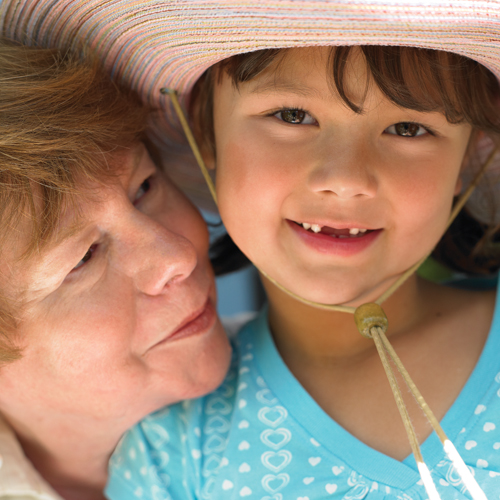
Sara May and I discuss the unfathomable mystery of tooth faeries.
Set aside an area that belongs to your grandchild. It can be as small as a drawer, a child-sized table, or a corner of a room (my grands like to hide out under an antique bed), but to your grandchild, it will feel like a home away from home.
To make her visiting grandchildren feel welcome whenever they spend the night, my friend Gramma Sharon Aderman lays a new T-shirt or pajamas on top of the bed and rests a paper plate “head” on the pillow. The “face” is either an enlarged photograph of the child’s face, or a drawing of the child with a fringe of yarn hair. This simple tradition tickles and comforts a child who may not be used to being away from home.
If your grandchild is scared of the first “sleepover,” pitch a child-sized tent next to your bed. That way your grandchild is having an adventure, feels protected and secure inside the enclosed tent, and has Granny just an arm’s length away. Tuck in a flashlight and include a favorite book or one that you’ve just discovered. It is exciting to sneak a midnight read by the light of a flashlight.
Dedicate a drawer to each grand so that they always have a change of clothes or pajamas when they come to visit. Such a small thing to do, but it makes a child feel like a true part of your household.
Nana Bonny didn’t have enough space in her bedroom for a tent, so instead she turned her closet into a “little room” and outfitted it with a sleeping bag, blankets, pillows, and a flashlight for her grandson, who loved the treat of staying in that cozy space.

This tall bed serves as the perfect indoor hideout and playhouse for my grands, who spend hours hidden beneath it.
Whenever you’re out on a walk, be on the lookout for great natural things to stockpile for your grandchildren’s visits. Since many of the treasures you can use for craft projects are only available during a certain time of the year, collect and store them until your grandchild arrives. Then, on a rainy day (see “Rainy Day Activities”) or a starry night, when you’ve exhausted all other modes of entertainment, drag out your bag of tricks for craft projects, mini faerie landscapes, or as games, toys, or subjects for drawing and painting.
Hang a big bulletin board, which we call a “life board,” on the wall and dedicate a section to each grandchild. Tack the child’s initials above his space, add a recent picture, and any art or other projects you want to display. When a youngster away from home sees a space dedicated to him, he immediately feels a sense of belonging. You’ll find that your grandchild will make things especially for the board and, upon arrival, will always check it to see what you’ve featured.
Before your grandchild visits in the summer, prepare a look-alike scarecrow to greet him. Ask his family to save some of the clothes (especially a favorite piece of clothing) your grandchild outgrew and send them to you in advance of his arrival.
Stuff the clothes with straw or crumpled newspaper in plastic bags that are tied closed. Use an old pair of panty hose, some fabric, or a gourd to make the head. Enlarge a current photo of your grandchild, laminate it, and glue it to the head of the scarecrow. Fill the head with stuffing and attach it to the neck of the clothing. Mount the body on a crossed pole in your garden. Place a hat on the scarecrow’s head, and scatter some sunflower seeds or peanuts on the brim to attract birds.
Build up a treasure trove of simple-to-play children’s games like Bingo, Pick-Up Sticks, playing cards, and board games. Keep the games visible in your living room or family room for frequent use whenever your grandchild visits. These games help a child learn sportsmanship, problem solving, interactive play, self-control, communication, motor skills, and more. So turn off your television and video games, and play.
Fill a basket with books for you and your grandchild to read aloud together. Buy the ones you love and borrow others. You may have kept some of the children’s classics that you and your children shared together. If so, reading them to the next generation will bring back fond memories and may lead to new discoveries. The local librarian is well versed in what books are suitable for every age and can help you choose some to check out before a visit. While at the library, pick up How to Get Your Child to Love Reading by Esme Raji Codell, which will steer you onto a course of good reading for every area of interest and all ages of children. Esme also gives good advice about reading out loud to children: “Make read-aloud time special. Gather around. Turn off the lights, turn on a cozy lamp . . . flop on pillows, be comfortable, be intimate. Love the book before you read it to children.”
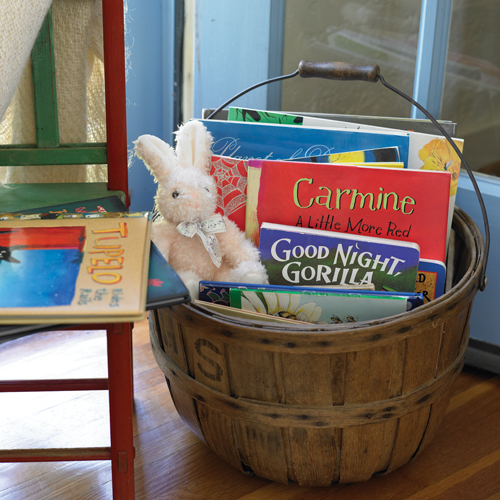
Keep a supply of good books in every room—even the bathroom.
My friend Mary Rae Means showed me a “mad basket” that she and her granddaughters made to help them deal with life’s little ups and downs. They sat together and the girls told her what people can do to make themselves happy. Each suggestion was written on a small slip of paper and dropped into the basket. Whenever the girls were mad or sad, they closed their eyes, reached into the basket, and pulled out a scrap of paper with a suggestion, such as, “Hug each other,” “Jump around the room on one leg,” “Dance,” or “Sing your favorite song.” They so loved the “mad basket” idea that they made them for other family members and gave them as gifts. Even a curmudgeon would find it tough to be grumpy when a family member is jumping up and down on one leg singing “Eensy Weensy Spider.”
Keep a big, flat, open basket on your coffee table within reach of little hands. Fill it with photos of your grandchild and other family members. Sit close to the basket and pick up photos, pass them to your grandchild, and talk about the person or animal pictured. Soon your youngster will turn to the basket without prompting from you. Our family photo basket is one of the first places our grandchildren head when they visit. They love to paw through the photos and look at them. Even when my grandson Moses was a year and a half old, he looked closely at the photos and passed them around. This basket will get much more use than a family scrapbook stored on a shelf.
In the children’s room, I keep a small chest of drawers that I stock with wonderful clothes, hats, crowns, old costume jewelry, worn-out watches, shirts, old glasses, evening purses, sunglasses, and the biggest hit of all, a long reversible cape, dark on one side, shiny red satin on the other. Both the boys, who become magicians and sorcerers, or the girls, who are princesses, queens, or faeries, use the cape whenever they can.
I scout out long pieces of fabric—from velvet to satin, inexpensive swaths of nylon netting, and cotton—that can be wrapped and tied to make skirts, shawls, and cloaks. My grandchildren dress up in their costumes when they’re playing make-believe or performing for a family gathering. It is amazing to see the transformation that occurs, not only in their voices, but also in the way they assume different characters and accents.

Visit thrift shops, dance stores, and flea markets for a range of quick costumes.
Using the patterns and instructions here, make a heavy paper cone and a crown. They’re great for dress-up and a birthday crown makes the day very special. Cut out stars and a moon from light paper and glue them in place. Spread a thin layer of glue on them, and sprinkle with glitter dust.
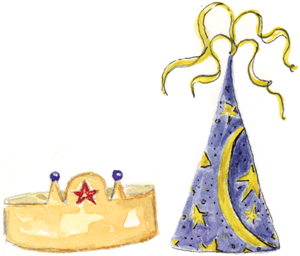
When my granddaughter Sara was a toddler, I invested in a lovely, handmade journal for writing my memories about her. I inscribed these words by Mary Oliver on the back page of the journal: “What is it you plan to do / With your wild and precious life?” Every time we were together and she said a new word or did anything out of the ordinary, I wrote about it in the journal. As grandmothers, we always think we’ll remember the time we first heard a special word or saw our grands do something memorable, but our memory banks are already fairly full, so it’s good to write those things down.
On each of my granddaughters’ birthdays, I glue a colorful envelope onto the page of the day and tuck a piece of family jewelry, a photograph, or special memento inside. I seal each envelope so that when they’re opened, many years from now, they will be a complete surprise for my grown-up grandchild.

Set aside some quiet moments alone to record your memorable times together.
By the time my first grandchild was born, most of my beloved aunts and uncles, grandparents, great-gran, and others had already passed away. I felt this broad hole in the fabric of our history and somehow wanted to introduce my granddaughter to multiple generations of her family.
For a month, I spent evenings sifting through boxes of ephemeral treasures and amassed a few dozen old photographs, some from as far back as the late 1800s. One rainy day, I sat in my studio and carefully put together a photo album, which included names and a bit about each person.
Nothing touches a child’s heart like storytelling, so I wrote a short story or family history to go along with each of the photos. For example, to accompany a photo of her great-great-grandpa John Clark riding his favorite horse, I wrote, “Here is your great-great-grandpa who was the last of the Arizona Rangers. He rode this horse through the Arizona Territory at the beginning of the twentieth century and searched the Grand Canyon for bandits.” I am amazed by how my grandchild remembers the stories, takes them into her life and history, and retells them to others. Through this, I feel that our family still lives and will as long as their stories are remembered and passed on.
Plant a birth tree for your grandchild somewhere in your yard or in a large pot. Introduce the child to his birth tree, take a photo of the two of them together, and measure their heights. Let your grandchild water and feed the tree whenever he visits. Start a photo journal of the two of them, and keep track of their growth through the years. You’ll be surprised by how important the tree will become to your child.

If you are going to plant just one pot of flowers in anticipation of a grandchild’s visit, make it big, broad-faced sunflowers. You can put the seeds into the soil as early as April, and the plants should be up and blooming within two months.
Small varieties and giant sunflowers can be planted in a large container filled with bagged potting soil. Sunflowers’ broad faces will attract butterflies, skippers, and bumblebees all day long. And, at night, they will lure amazing moths (see here) to the nectar on their disk blooms. Sunflower leaves make delicious salads for hungry birds. In the fall, the dried sunflower heads can be set out to feed the birds.
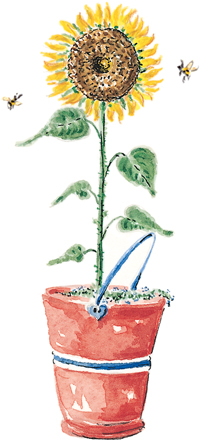
This sunflower—planted for me by a bird or squirrel—appeared in a bucket of soil.
Start amassing artifacts for a family time capsule that you will bury together. Find a sturdy box with a tight-fitting lid and tuck in some old toys, a coin with the current date, a letter from your grandchild with a current photo, a family photo with the date noted, a picture of a family pet and a story about the pet, some important newspaper headlines, or a news magazine front cover and story. Make a recording of your voices and sing a song together. Voices change constantly, and the memorable yet ephemeral sound of a loved one’s voice is to be treasured.
Find an area outdoors that isn’t destined for a construction project or any other disturbance. Seal your box of artifacts in an airtight container like a lidded plastic box or Rubbermaid container, and bury it at least a foot deep. Stick a pole or stake into the ground above the capsule to mark its whereabouts (believe me, you think you’ll remember where you buried it, but you won’t). Wait a couple of years (or longer) before unearthing your time capsule. You’ll be surprised by how exciting this is for a youngster, and by the changes that have occurred.
Many years ago, a friend told me of the Japanese tradition of keeping a tokonoma, an alcove in her home for the display of scrolls, flowers, natural objects, and pieces of art. The arrangement is usually changed daily, which helps keep senses fresh, aware, and stimulated. When our surroundings remain static, we stop seeing things, even when they are beautiful and rare.
I began the custom in my own home, taking time out from chores to find an opening flower, the castanet seedpod of a jacaranda tree, a scattering of sea-washed mermaid’s tears (sea glass), or whatever was wonderful and new to my eye. Now, when my grandchild comes to visit, it is a special treat for her to seek out natural objects for the tokonoma display in the hallway. Each new arrangement or single item is perfectly placed, admired, and appreciated fully.
When you are outdoors with your grandchild, you might point out something that would be nice for the tokonoma, but leave it to him to decide what items he wants in the display. Your job is to step back and admire and praise.
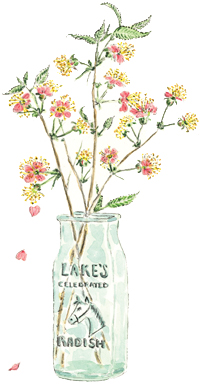
The fleeting beauty of a branch of apple blossoms will take center stage in your tokonoma.
Most grandchildren aren’t with their grandparents enough time to warrant a sandbox, which might be used only once or twice a year. But sandboxes and kids go together like peanut butter and jelly, so here is a short-term solution. Purchase play sand from a garden center or home- and landscape-supply store. Fill a large wheelbarrow or a small child’s swimming pool with the sand, a bucket, dishpan, cups, shovels, a plastic squirt bottle full of water, spoons, pots, and plastic bowls.
Nothing beats a fresh, handy mud puddle for making the best mud pies and to add variety and texture to sandbox projects. Fill a big bucket or container with gooey mud, and set it close to the sandbox. You’ll be amazed by the hours your grandchild will spend outdoors making mud pies, building sand castles, even mini mud cities.
Note: In case neighborhood cats visit your sandbox, cover the sand with aluminum foil, newspaper, or a piece of chicken wire. Cats can’t stand to walk on the foil, paper, or wire, and it thwarts their attempts to dig.
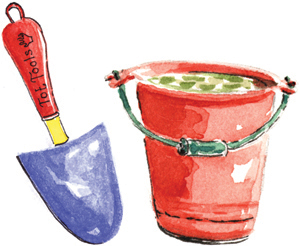
When I was a child, my grandmother often celebrated our lazy summer afternoons together with a cup of tea (mine was mostly cream) and some cookies or a freshly baked bit of pie crust sprinkled with cinnamon sugar. Grandmother had a grown-up teapot, cup, and saucer, and I had a miniature Chinese-style blue willow tea set, which fit perfectly into a small picnic basket.
I so cherished our beloved tradition of sharing teatime together that when my granddaughters were born, a miniature tea set in a basket became one of my first purchases. By the time the girls were two and a half, they were old hands at the art and ceremony of tea parties, and they even spoke with amazing British accents. So, although I don’t normally urge anyone to spend money, I do hope you’ll find the perfect tea set for your grandchild, and then invest in the time to have a tea party and a treat whenever you two have the chance to play together.
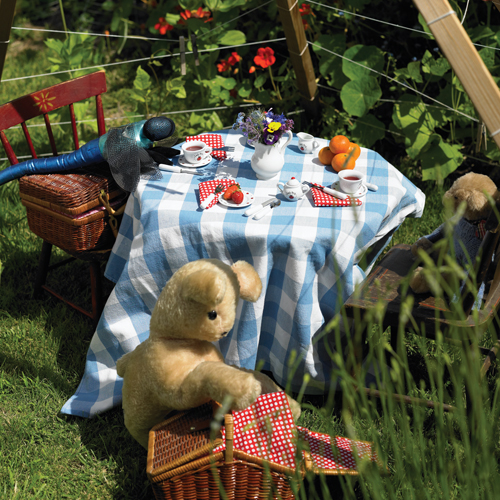
Anytime is tea-party time when a Granny and grandchild are together.
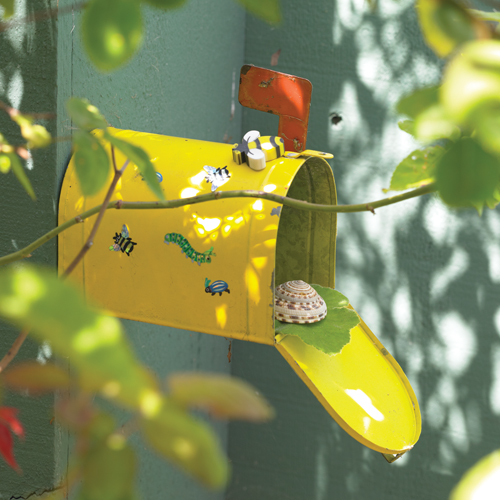
Painted wishbones, decorated leaves, shells, flowers, and other natural objects are favorite gifts from the faeries.
Whenever I ran into Grandmother’s garden as a child, I’d head straight for the sycamore tree. Would I find another little gift from the garden faeries? One day when I knelt beside the hole at the base of the tree, I found a small box filled with brightly colored stones. When I rushed indoors to show them to Grandmother, she dropped the rocks, one by one, into a water-filled gallon jar on the breakfast-nook table. During the day, we watched as the rocks miraculously changed from little lumps into a forest of rainbowed stalagmites. How did those faeries always know what would tickle the imagination of a young and curious child?
The wonder and joy I felt whenever I discovered those hidden treasures stayed firmly planted in my memory. I wanted to start my own tradition of faerie gifts for my grandchildren, but didn’t know exactly what to do. One day in a craft store, I stumbled across some miniature galvanized tin mailboxes that looked just like the real thing. They even sported little flags, which the faeries could raise whenever they left a gift inside. We painted each box a different color—purple for Ilyahna, pink for Sara May, bright yellow for Asher, and red for Moses. You could also make a mailbox out of wood and custom paint it with your grandchild’s name and favorite color.
We mounted the mailboxes on fence and porch posts in hidden areas throughout the yard. As soon as the children arrive for a visit, they sprint through the garden straight to their mailboxes to check for surprises from the faeries.
I try to make the faeries’ gifts small, homemade, and as natural as possible, though sometimes I tuck in magical stickers, wooden toys, mini magnifying glasses, or dollhouse accessories. Once I made a purse out of a skeletonized tomatillo husk that I beaded and decorated with golden thread. Another time I put together a miniature tea set out of love-in-a-mist pods and acorn caps. I often write leaf notes from the faeries using Pilot silver and gold pens (fine point) to make them seem magical. No wishbone is ever wasted here; they’re painted, tied with silver and gold threads and bells, and left inside the mailbox for my grandchildren’s wishes.
What is really wonderful is that now my grandchildren often leave thank-you notes and gifts for the faeries. They’re learning how important it is to give as well as to receive.
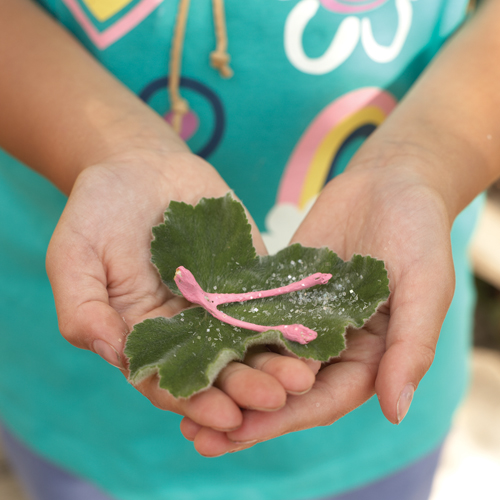
A painted wishbone is cradled in a velvety pelargonium leaf and sprinkled with faerie dust.
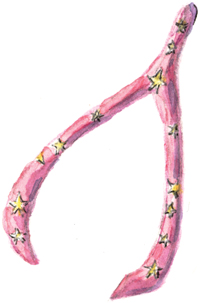
You already have a built-in faerie mailbox if you have a tree with a hole in it. If possible, make a tiny door to cover the hole, and construct a mini flag to hang from a twig to indicate when the faeries have been there.
As a child, I spent countless hours building faerie houses, making miniature faerie gardens, and serving pretend tea and food to my wee unseen visitors. My neighborhood friends, both boys and girls, slipped into the moment and gathered snails for slow-paced faerie chariots, picked an array of blooms for clothing and crowns, and helped serve tiny foods made from mud and colorful flower blossoms.
I’ve found this child’s faerie play to be universal, from the dappled woods of Sweden to the hidden forests of Monhegan Island, Maine, where children and grown-ups create magical faerie houses using only nature’s toy chest for materials. When given a chance to play outdoors, children inevitably invite the faeries to be a part of their lives.
I watched in awe as my granddaughter Ilyahna laid out a perfect faerie landscape under the pine tree. Her stockpile of leaves, flower petals, twigs, moss, acorns, shells, and pods were fashioned into beds, rugs, tiny chairs, and dishes fit for even the most discriminating of faeries.
The strange thing is that she did this before I had the chance to teach her about making a faerie garden. I had been looking forward to initiating her into the ways of the faerie-folk, but like most children, she was privy to all that knowledge without needing any help from a grown-up. She instinctively reached for some of the beautiful and natural objects scattered throughout the yard and began the quiet and joyful work of creating magic.
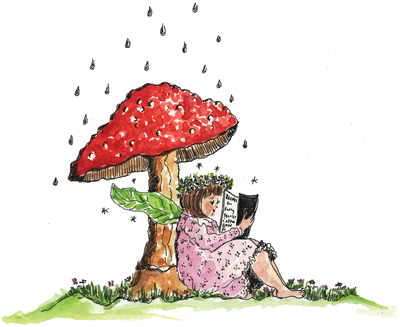
Children lose themselves in the miniature world of faeries and their homes and gardens.
You can make faeries a part of your grandchild’s life by providing some areas for play and a ready supply of natural objects. Before your grandchild arrives for a visit, set the scene for a faerie landscape. Find a shaded area of your yard (under big bushes or trees) and clear a circular space for your grandchild’s hidden faerie garden. Smooth the soil and outline the circle with pinecones, acorns, twigs, shells, or rocks. Plant the circle with a collection of small bulbs or coral bells, a plant the faeries love. Fill in the circle with a cushion of soft mosses or mulch.
Be on the lookout for wonderful shells, pebbles, rocks, pods, cones, twigs, lichen, mosses, and leaves—anything that would work for outfitting a faerie house and garden. Around the time of a child’s visit, nestle your natural finds throughout the yard or garden and near the cleared faerie space.
When your grandchild arrives, walk outside together and discover the magical circle. Stroll through the yard and find some of the natural objects you’ve seeded there. As you gather them, talk about what they look like and what they might become in a faerie garden or house.
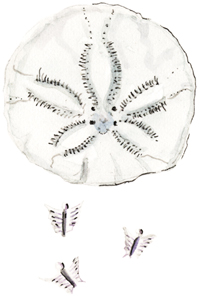
A sand dollar makes a great tabletop. When a sand dollar is broken, little white angels fall out.
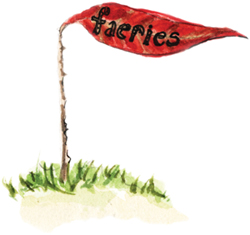
Leaf flag
Wherever you look outdoors, you’ll find natural treasures to build and furnish a faerie house.
|
|
Chinese-lantern floor lamp. |
Pussy willows for faerie pillows. |
|
|
Curled leaf chaise with woolly lamb’s ear for an afghan. |
Hollyhock footstool. |
|
|
Chestnut bed and rose-petal blanket. |
Scallop-shell headboard. |
|
|
Leaf-and-twig tepee. |
Rosehip teapot and acorn cups. |
|
|
Acorn birdhouse. |
Pinecone scales for shingles. |
|
|
Teapot with grapevine handle and spout and love-in-a-mist sugar bowl. |
Mussel-shell bathtub. |
|
|
Thin rounds of branches for tables. |
Sycamore “button” for a modern lamp. |
|
|
Berries for architectural embellishments. |
|
Not all grandmothers are lucky enough to have their grandchildren living nearby. Time together may be limited to holidays or a long summer visit, but a faraway grandmother can still play an important part in the life of her grandchild. The simplest remembrances, conversations, letters, and traditions can keep the intimate bond between a grandmother and child flourishing across the miles.
Gramma Sharon Aderman showed me the way she refreshes her youngest (and too far away) grandchildren’s memory of her. She had photos of the faces of herself and Grampa Jim enlarged, mounted on cardboard, and pasted to paint sticks, which she sent to her daughter. Whenever she calls her grandkids, her daughter and son-in-law hold the photos up so that the grandchildren associate the voices with the pictures.
Send a photo of you and your grandchild doing something together to your grandchild’s parents and ask them to use it as a screen saver. Some screen savers constantly scroll through a series of photos. You’ll find that your grandchild will see the photo and talk about the experience with his parents. And your memory will remain fresh in his mind.
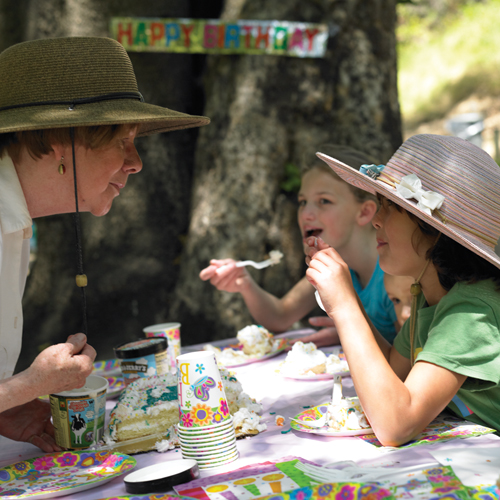
Use a favorite photo as a screen saver.
Make a habit of sending your grandchild a book a month. Focus on special subjects that you may encounter when you’re together. For example, these inspirational faerie stories would make a good choice before you begin building faerie houses and gardens: A Fairy Went A-Marketing by Rose Fyleman (recently reprinted), the Fairy Houses series by Tracy Kane, and Fairy Island by Laura and Cameron Martin.
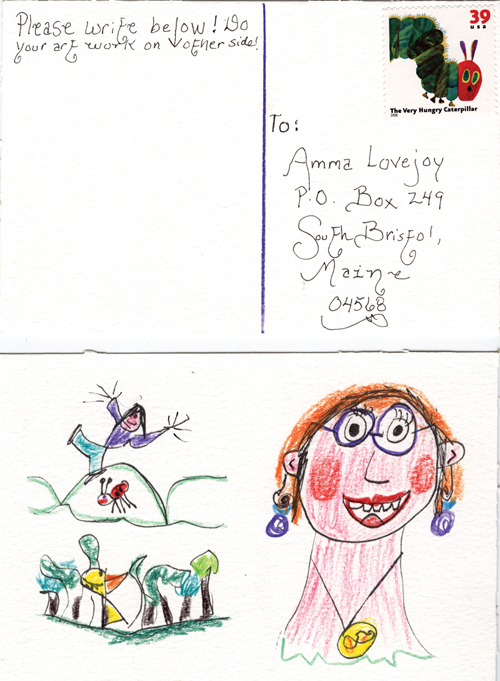
Handmade postcards will track the life, interests, and skills of your young artist through the years.
I always want to hear from my grandchildren, but when they sit in front of a large sheet of stationery, they feel daunted by the prospect of having to fill the entire page. To navigate around this fear, I go to the local art and craft store and buy small pads of watercolor-weight blank postcards. They’re the perfect size, and they are great for your grandchild’s paintings or drawings. If you can’t find these pre-made postcards, cut out your own from watercolor paper. Address the postcards to yourself, stamp them, and give them to your grandchild. Ask his parents to encourage him to sit down and write or draw you something every couple of weeks. Have someone photograph you holding the card when you receive it, then tuck the photo into your next letter to your grandchild. Though you are out of sight, a steady stream of letters and photos means you’ll never be out of your grandchild’s heart. Keep the handmade cards in a personal scrapbook. The next time you’re together, you can read the cards aloud.
Years ago, Grammy Marilyn Brewer showed me a stack of birthday cards she was mailing to her granddaughter Kara. “On every birthday, I send a card for each year in Kara’s life.” What grandchild could ever forget a grammy who flooded the mailbox with cards? They can be homemade, so the only expense is paper, envelopes, stamps, and time.
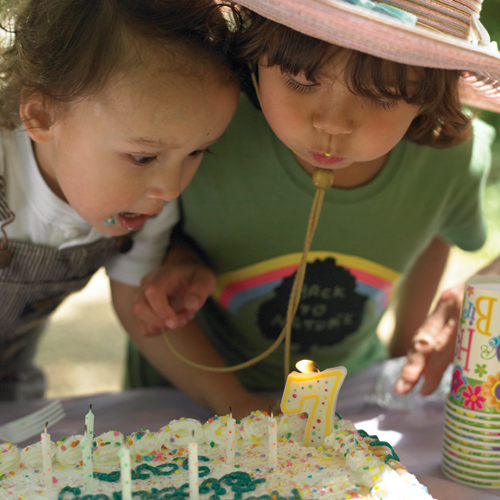
If a birthday falls on a date when you’re not together, you can create an event anytime.
My granddaughter Sara May’s birthday comes in midsummer when I am living in Maine. She was always so sad to have me miss her special day, but I remedied the problem by making it a tradition to celebrate her birthday a month in advance. I do it just as I do for the other grandchildren: decorations, a birthday banner, a fancy cake (in her favorite color), party favors, and of course gifts. She no longer mourns my absence. Two birthdays a year is exciting for any child.
The next time your grandchild asks if you’ll be attending the big birthday celebration, assure him that although you won’t be there at the party, you will have another birthday extravaganza the next time you’re together.
Buy or make a family address book for your grandchild and include cousins, aunts, uncles, in-laws, and good family friends. Fill out all the information from A to Z, including each person’s birthday. When you are with your grandchild, take out the book and look for birthdays to remember. Start this tradition even before your grandchild begins school. Make simple cards with drawings or let your grandchild call or send an e-mail. This is a great way to teach your grandchild to give of time and love whenever possible.
Whenever I am away from home, I send my grandchildren a weekly letter—a real letter, sealed in an envelope and written with love and care. I want them to know that they are always in my heart and mind. I tuck small gifts inside each envelope, and many times I illustrate the notes with small sketches or paintings, and use silver or gold markers instead of pens.
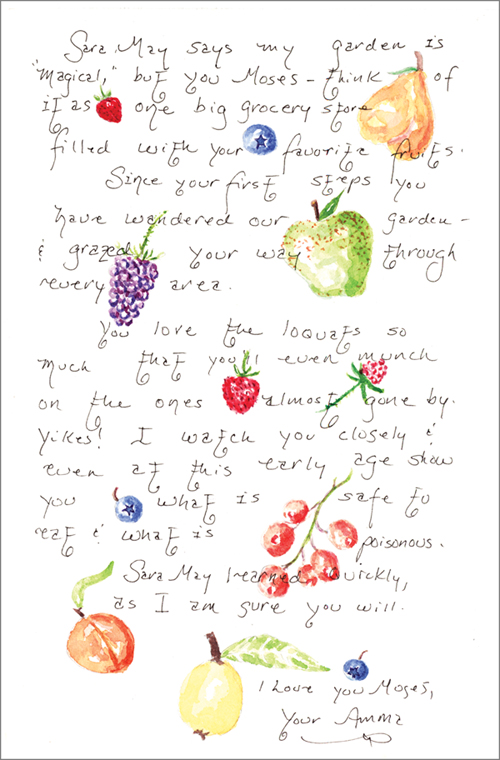
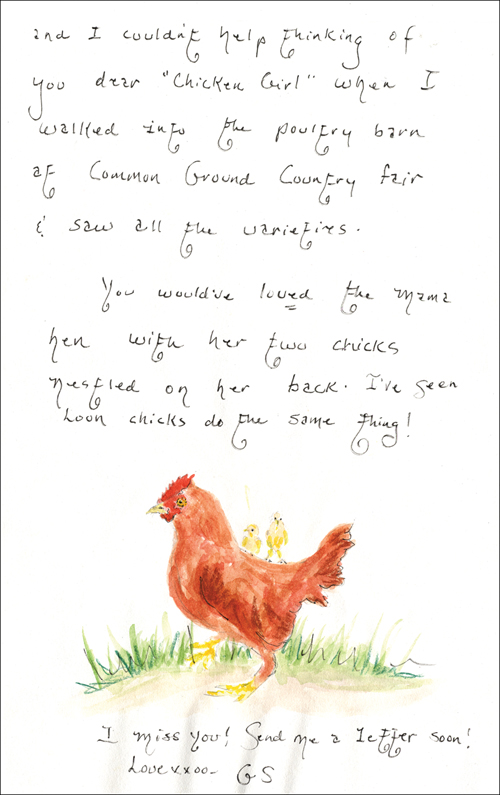
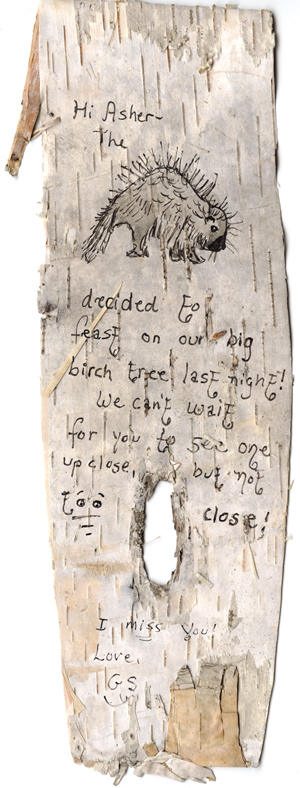
How do you keep those memories of your times together alive when your grandchild lives far away? Whenever you’re together, take photographs of your adventures, meals, journeys, and projects. (Do it so often that your child becomes oblivious to the camera-wielding grandma.)
After your grandchild leaves, use your talents to make a vacation book of your adventures. Write a story about your good times, put in some of your grandchild’s direct quotes, and add a liberal dose of photographs throughout. Send the completed book to your grandchild for a holiday or birthday.
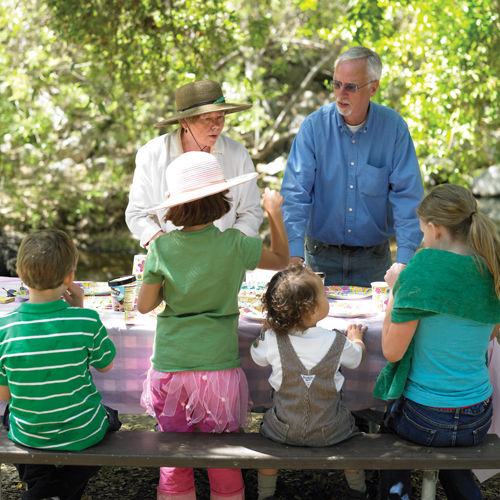
Family photos keep memories alive for generations. Be sure to date the back of every photo and identify each person.
Grandchildren love to see old photographs of their parents when they were their age. Every holiday, find a family photograph that corresponds with the age of your grandchild, enlarge it, paste it onto a card, and mail it to your grandchild. The old photo is guaranteed to stir up memories and stories.
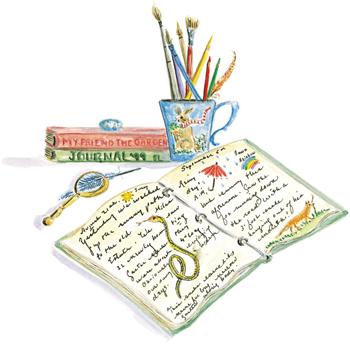
Send an inexpensive plastic camera to your grandchild and include a pre-addressed and stamped padded envelope for its easy return. Equipped with a camera, a child feels important and powerful and will gladly snap photos to share with Granny. So when you ask your grandchild to show you what her life is like by taking pictures of her friends, pet, school, and trips, you will surely get a response. Have her parents mail the camera back to you, so that you can get the film developed and share in a part of her long-distance life away from you. When she visits, you can talk about the pictures.
Whenever you and your grandchild read together, take note of the most beloved stories—the ones you’re asked to read over and over. After your grand leaves for home, record some of the short stories to send to him. As you read, ask direct questions, such as, “And, what did the tiger say?” or “How did the people react when the spider dropped down in front of them?” The questions allow your grandchild to participate in the story just as when you read in person. Send your recorded goodnight stories in an “I already miss you so much” box, which may also include a small recorder (digital or tape) and some simple mementos of your time together.
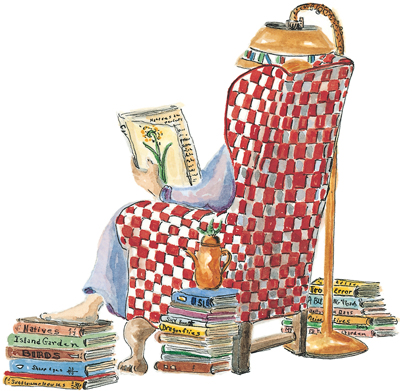
Spend a quiet morning recording your grandchild’s favorite stories.
Once a month, make a special bookmark for your grandchild and send it to him. Choose a family photograph, a photo of a favorite pet or place to visit or a favorite book or food—anything that will remind your grandchild of your good times together. Laminate the bookmark so that it will last.
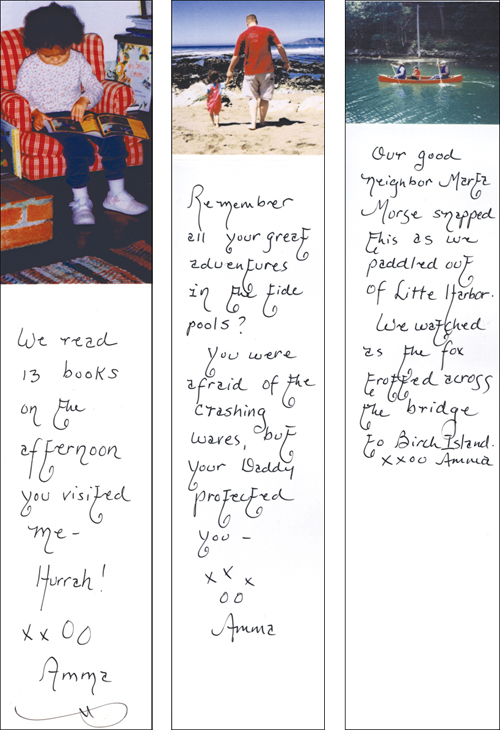
Ask your grandchild to send you a favorite word of the month. Encourage her parent to help the child peruse the dictionary for funny and unusual words or ones that are difficult to use in a sentence. The object is to stump Granny, who must write back a funny sentence using the grandchild’s word. Some of my favorites so far have been stupendous, flabbergasted, dillydally, and nincompoop (see the book Carmine: A Little More Red by Melissa Sweet for some great words).
Collect a selection of jokes specifically targeted to your grandchild’s age. Once a month, call your grandchild and tell her a joke or e-mail her parents with a joke from you. Chances are your grandchild will have a joke to fire back at you.
On the day your grandchild is born, purchase a copy of a magazine or newspaper with the date. When he is older, you can pull out the paper and let him read about what happened on the momentous day he was born.
My grandchildren are fascinated by the road atlas we keep in the backseat of our car. They love to pull it out of the seat pocket and follow the route from our house in California to our cottage on an island in Maine. They get excited by the names on the map, the cities, the rivers, and the ocean, and they ask questions about areas of the United States that they’ve never visited. The questions inevitably lead us to many tales about our journey to Maine and the places to visit along the way. Maps are a great way to give your grandchild a knowledge of and easy familiarity with the faraway place that he will (hopefully) visit someday.
Select a map of the country to send to your grandchild, and use a marker pen to highlight the way to your house. Indicate places you visited along the way from his house to yours, and include photographs of special places you might visit together someday (zoos, botanic gardens, museums, rivers). As you travel, send a postcard from each place you stop, telling stories of the adventures you’re having en route.
I dreaded the car travel that was usually a big part of family vacation time. Grandmother Lovejoy solved the problem of my boredom by fixing up a special travel bag, which I couldn’t open until we had been on the road for at least a half hour. Once an hour, after the initial opening, I was allowed to reach inside the closed bag and fish out one thing. Usually it was something simple like a set of magnets, a peel-back Magic Slate, tiny coloring books and crayons, Old Maid or Go Fish playing cards, or a notepad for playing hangman or tic-tac-toe. No matter what she supplied, I was always thrilled and the little travel bag of tricks kept me contented for hours.
If there’s one thing you always want to have on hand for whenever your grandkids arrive, it’s bubbles. No true grammy would ever be caught bubble-less. Even older kids love to play with them, and they’re easy to make from the common household ingredients below. Bubbles store well if kept tightly lidded in the cupboard.
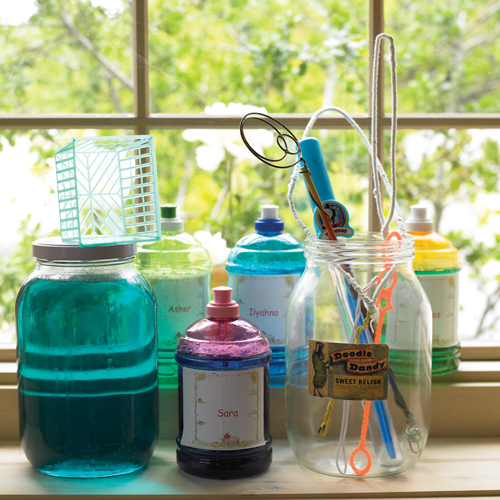
Keep your bubble supplies in an accessible area within easy reach of little hands.
2 cups water (distilled water works best)
½ cup blue Dawn (not Ultra) dishwashing detergent
¼ cup light corn syrup or glycerine (found in skin care sections of pharmacies)
Gently stir the ingredients together and try not to create foam. Pour the mixture into a lidded plastic container and store it overnight before using. Mix gently and pour the bubble mixture into a tub or large plant saucer. Dip a wand in and blow!
6 cups distilled water
2 cups original Blue Dawn (don’t use Ultra)
1 cup light corn syrup
For a big party, you’ll want to make a super-duper batch. Use a small, clean tub (Rubbermaid makes lidded 3-gallon tubs, which are about 11 inches by 16 inches). Pour the ingredients slowly into the tub and mix gently and thoroughly trying not to create foam. Use a giant, homemade bubble wand to stretch and trail your jumbo bubbles.
Ilyahna coaxes a family of bubbles from the basket.
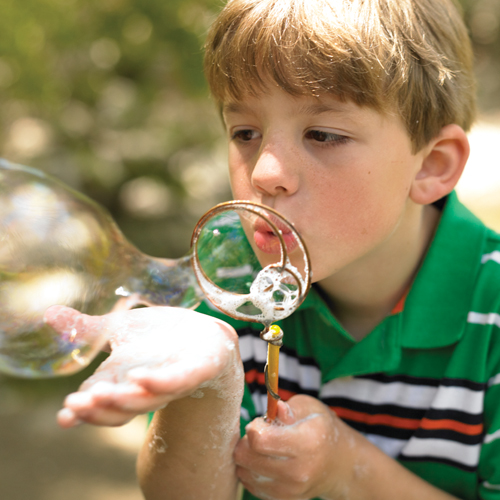
Asher tries for a prize-winning sausage-shaped bubble.
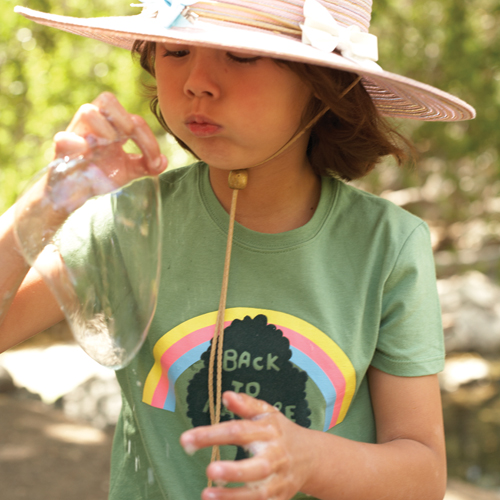
With wet fingers, Sara can blow big bubbles without a wand.
Stretch a coat hanger into an elongated circle. Wrap the handle in tape to prevent scratches on little hands. Wrap the circle of the wand in cotton string or chenille stems, which will absorb and hold more solution for longer blowing. Use plastic strawberry or tomato baskets to blow clusters and strands of conjoined bubbles.
Dip your hands into the soapy water and you’ll be able to gently poke your finger into the side of a bubble without popping it. Fill a jar lid with your bubble solution. Dip a drinking straw at an angle into the bubble mixture until it is wet halfway up the straw. Now carefully (without letting your lips touch the bubble solution) insert the wet straw into a bubble and blow gently. You’ll blow a big bubble and if you wet your finger and poke it into the bubble you’ll form a family of little bubbles.
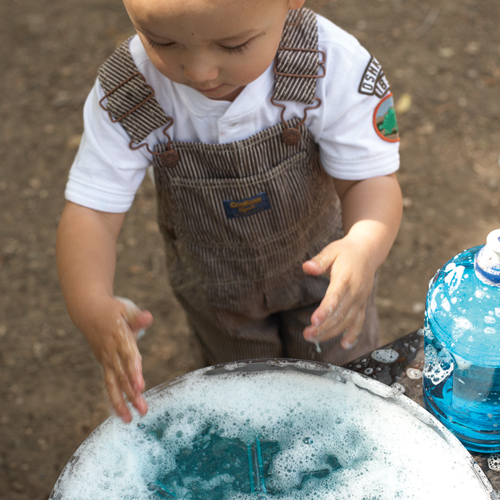
Toddlers like Moses are just happy to play in the mixture.
“One of the luckiest things that can happen to you in life is, I think, to have a happy childhood.”
Agatha Christie
